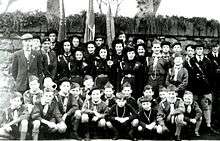Dick McKee
Richard “Dick” McKee (Irish name Risteárd Mac Aoidh; 4 April 1893 – 21 November 1920) was a prominent member of the Irish Republican Army (IRA). He was also friend to some senior members in the republican movement, including Éamon de Valera, Austin Stack and Michael Collins. Along with Peadar Clancy and Conor Clune, he was killed by his captors in Dublin Castle on Sunday, 21 November 1920, a day known as Bloody Sunday that also saw the killing of a network of British spies by the "Squad" unit of the Irish Republican Army and the killing of 14 people in Croke Park by the Royal Irish Constabulary (RIC).[1]
Early life
McKee was born at Phibsborough Road in Dublin on 4 April 1893. He became an apprentice in the publishing business at Gill & Son, Upper O'Connell Street, and then a compositor.[2]
Paramilitary career
McKee joined the Irish Volunteers in 1913, serving in G Company, Second Battalion of the Dublin Brigade. He served in the 1916 Rising in Jacob's Factory, under the command of Thomas MacDonagh.[3] McKee was later incarcerated by the British Army in Knutsford Gaol and at the Frongoch internment camp in Wales.
McKee was promoted within the IRA shortly after his release. He became Company Captain and then Commandant of the Second Battalion, eventually being placed as Brigadier of the Army's Dublin Brigade. He was also active as an ex-officio member of IRA General Headquarters Staff - which included Collins, Richard Mulcahy and Russell. He was a prime innovator in the formation of the flying columns along with Mulcahy and Collins. He was Director of Training for this duration, though he was jailed again as a political prisoner in Dundalk Jail, in 1918.
McKee had many escapes and close shaves during the Anglo-Irish War, and in the final chapter of his revolutionary activism, he was on full-time active service, moving covertly through a network of safe houses.
He was engaged to May Gibney, a volunteer during the Easter Rising and an active member of Cumann na mBan.[4]
The Squad
In July 1919 Collins asked McKee to select a small group of men to form the Squad.[5]
Arrest and death
McKee was betrayed to Crown forces by an ex-British Army soldier, James "Shankers" Ryan, and captured at Sean Fitzpatrick's before Bloody Sunday by the Royal Irish Constabulary. (In retaliation, on 5 February 1921, an IRA squad led by Bill Stapleton walked into Hynes' pub in Gloucester Place and shot Ryan dead.)[6]
Brought to Dublin Castle he was tortured under interrogation with Peadar Clancy and Conor Clune from County Clare.[7] The three would later be shot on 21 November 1920. The official account was that he and the other men with him were shot while trying to escape.[7] This account was widely disputed at the time, although some historians believe it was actually true.
A book titled Death in the Castle: Three murders in Dublin Castle 1920, written by Sean O'Mahony, and published by 1916–1921 Club records both the life and deaths of the three Republicans.
Burial
McKee and Clancy's tricolour-adorned coffins lay side by side at St. Mary's Pro-Cathedral on Marlborough Street, Dublin. Aged 27 and 32 years, respectively, they were laid to rest at the Republican Plot in Glasnevin Cemetery.
McKee Barracks in Dublin is named after Dick McKee.
References
- Sean O'Mahony, Death in the Castle: Three murders in Dublin Castle 1920. 1916/1921 Club
- Dublin Folklore Project report - November 2000
- An Phoblacht - Murder in the Castle - 22 November 2001
- McCoole, Sinead (22 February 2016). "Seven women who played a key part in 1916 and beyond, impacting on society". Irish Examiner. Retrieved 23 February 2016.
- CIA Studies in Intelligence, V13:1-69-78 (1969) - Michael Collins and Bloody Sunday
- Where's where in Dublin: a directory of historic locations, 1913-1923 Joseph E. A. Connell, Dublin 2006
- DublinCastle.ie - History of Dublin Castle - Chapter 16 Archived April 30, 2008, at the Wayback Machine
- The Grave of Clancy and McKee in the Republican Plot, Glasnevin Cemetery Dublin.
 Commemorative plaque in memory of the Volunteers killed in Dublin Castle 1920
Commemorative plaque in memory of the Volunteers killed in Dublin Castle 1920 Dick McKee commemoration, November 1958
Dick McKee commemoration, November 1958